At Chalmers, we use Cadence tools provided through the Cadence Academic Network extensively, in both teaching and research
The Cadence Academic Network was launched in 2007 by Cadence EMEA. The aim is to promote the proliferation of leading-edge technologies and methodologies at universities renowned for their engineering and design excellence. A knowledge network among selected European universities, research institutes, industry advisors, and Cadence was established to facilitate the sharing of techology expertise in the areas of verification, design, and implementation of microelectronic systems. The Cadence Academic Network, therefore, significantly supports and improves the university activities. More information may be found on the Cadence website and also in LinkedIn.
The Department of Computer Science and Engineering conducts research and education in digital and mixed-signal electronics design, much of it with a focus on single-chip integration. We use a Cadence-based digital-ASIC toolchain to realize our research designs. The master program in Embedded Electronics System Design inludes a range of courses which use Cadence tools:
- MCC092 Integrated circuit design: Students use Cadence software and a Cadence toolkit to design and simulate cells at the transistor level. Layout of standard cells is also included, and students use Cadence DRC and LVS tools for verification.
- DAT116 Mixed-signal System Design: In the Mixed-signal System Design course, we use Cadence software to illustrate matching problems and parameter spread, and couple these properties into system-level simulation tools
- DAT110: In the Methods course, we make use of a digital-ASIC design flow based on different Cadence tools. We use Incisive for verification, Genus for synthesis, and Innovus for place&route of implementations based on ASAP7 cell libraries.
Recent research work includes single-chip designs for high-performance wireless transceivers and for fiber-optical networks. Much of our research is in cooperation with colleagues in industry and academia, in particular from neighbor departments within Chalmers.
The Department of microtechnology and nanoscience conducts research and education in high-frequency electronics for wireless, remote sensing, and optical applications. Several research groups at the Microwave Electronics Laboratory use Cadence tools for circuit design and analysis in SiGe BiCMOS, CMOS, GaAs and GaN HEMT and InP HBT technologies at carrier frequencies from 10 to 300 GHz, conducting 4 to 8 tapeouts per year involving Ph.D. and Master’s students. Current research areas include wideband sub-THz transmitter and receiver circuits for wireless transmission and dielectric waveguides, efficiency enhancement and linearization techniques for transmitters, particularly for massive MIMO and point to point backhauling applications.
Cadence is a registered trademark of Cadence Design Systems, Inc, 2655 Seely Avenue, San Jose, CA 95134.
